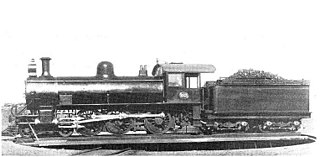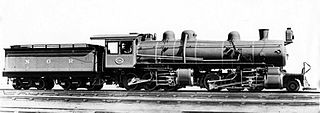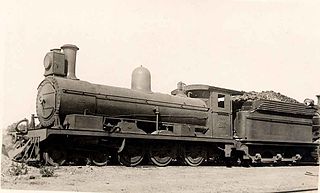
The South African Railways Class 10 4-6-2 of 1904 was a steam locomotive from the pre-Union era in Transvaal Colony.

The South African Railways Class 8X 2-8-0 of 1901 was a steam locomotive from the pre-Union era in the Cape of Good Hope.

The South African Railways Class 8Y 2-8-0 of 1903 was a steam locomotive from the pre-Union era in the Cape of Good Hope.

The South African Railways Class 8 4-8-0 of 1902 was a steam locomotive from the pre-Union era in the Cape of Good Hope.

The South African Railways Class 8E 4-8-0 of 1903 was a steam locomotive from the pre-Union era in the Cape of Good Hope.

The South African Railways Class 8F 4-8-0 of 1904 was a steam locomotive from the pre-Union era in the Cape of Good Hope.

The South African Railways Class 6G 4-6-0 of 1901 was a steam locomotive from the pre-Union era in the Cape of Good Hope.

The South African Railways Class 6L 4-6-0 of 1904 was a steam locomotive from the pre-Union era in the Cape of Good Hope.

The South African Railways Class 6Y 2-6-2 of 1903 was a steam locomotive from the pre-Union era in the Cape of Good Hope.

The South African Railways Class 5B 4-6-2 of 1904 was a steam locomotive from the pre-Union era in the Cape of Good Hope.

The South African Railways Class 4 4-8-2 of 1911 was a steam locomotive from the pre-Union era in the Cape of Good Hope.

The South African Railways Class Experimental 1 4-6-2 of 1907 was a steam locomotive from the pre-Union era in the Cape of Good Hope.

The South African Railways Class Experimental 2 2-8-0 of 1902 was a steam locomotive from the pre-Union era in the Cape of Good Hope.

The South African Railways Class Experimental 3 2-8-0 of 1903 was a steam locomotive from the pre-Union era in the Cape of Good Hope.

The South African Railways Class Experimental 5 2-8-2 of 1906 was a steam locomotive from the pre-Union era in the Cape of Good Hope.
The South African Railways Class Experimental 6 4-8-0 of 1906 was a steam locomotive from the pre-Union era in the Cape of Good Hope.

The South African Railways Class MA 2-6-6-0 of 1909 was a steam locomotive from the pre-Union era in the Natal Colony.
The Cape Government Railways 1st Class 2-6-0 of 1879 was a South African steam locomotive from the pre-Union era in the Cape of Good Hope.

The Cape Government Railways 5th Class 4-6-0 of 1890 was a South African steam locomotive from the pre-Union era in the Cape of Good Hope.

The Cape Government Railways 5th Class 4-6-0 of 1891 was a South African steam locomotive from the pre-Union era in the Cape of Good Hope.





















